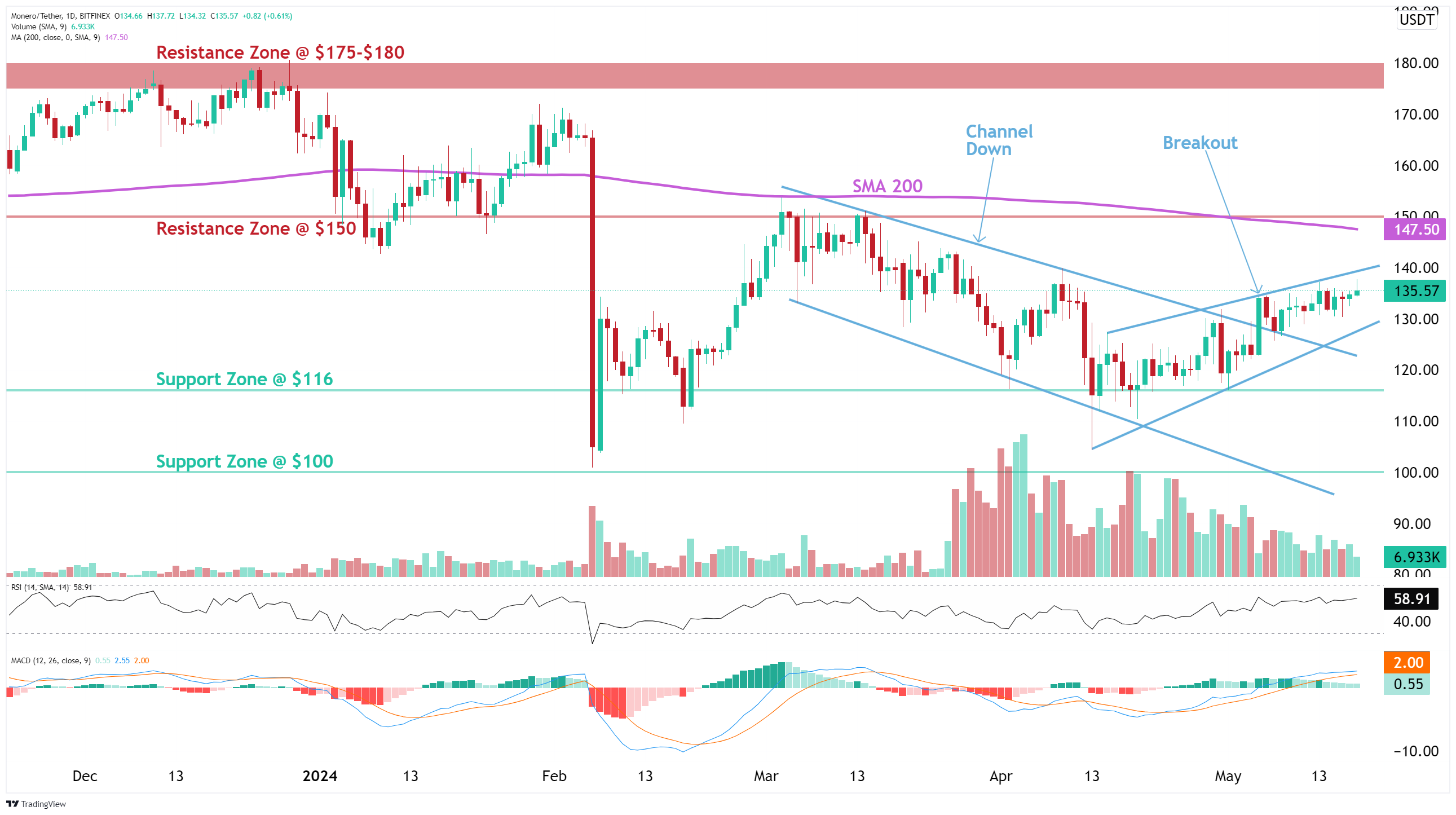Monero (XMR) Analysis
Monero (XMR) Analysis
In addition to automated chart patterns, altFINS’ analysts conduct technical chart analyses of top 30 cryptocurrencies. We call these Curated Charts and they evaluate 5 core principals of technical analysis: Trend, Momentum, Patterns, Volume, Support and Resistance.
Monero (XMR) technical analysis:
Trade setup: Bullish breakout from Channel Down pattern was confirmed with a retest and rebreak above $134. Price could price revisit $150 resistance level and 200-day moving average. Learn to trade breakouts in Lesson 7. Overall, price is in a downtrend until it breaks back above that 200-day MA. (set a price alert).
Pattern: Price was trading in a Channel Down pattern. With complete patterns (i.e. a breakout) – initiate a trade when the price breaks through the channel’s trendlines, either on the upper or lower side. When this happens, the price can move rapidly in the direction of that breakout. Learn to trade chart patterns in Lesson 8.
Trend: Uptrend on Short- and Medium-Term basis and Downtrend on Long-Term basis.
Momentum is Bullish but inflecting. MACD Line is above MACD Signal Line and RSI is above 55 but momentum may have peaked since MACD Histogram bars are declining, which suggests that momentum is weakening.
Support and Resistance: Nearest Support Zone is $116, then $100. The nearest Resistance Zone is $150, then $175 – $180.
See live Monero (XMR) chart here
See more curated charts of coins with technical analyses.
Recent news and research:
Monero’s Privacy-Focused Crypto Protocol Upgrade Is Now Live
Monero Developers Disclose ‘Significant’ Bug in Privacy Algorithm
What Are Privacy Coins? Monero, Zcash, and Dash Explained
Monero Team Receives Anonymous $500,000 Donation.
Find more real-time news here.
What is Monero (XMR)?
Find full description and news on altFINS platform.
Overview
Aimed at privacy-preservation and fungibility, Monero is a Bytecoin code fork providing anonymous value transfer through ring signatures, stealth addresses, confidential transactions, and bulletproofs. Monero offers anonymity by default in contrast to the optional privacy preserving functionalities of its peers. In pursuit of decentralization Monero continually changes its proof-of-work algorithm in order to prevent ASICs from dominating and centralizing the mining process.
History
Monero traces its origins back to Bytecoin, the first implementation of CryptoNote, which was an application layer protocol aimed at solving various issues with Bitcoin such as traceability, mining centralization, and irregular coin emission. Bytecoin launched in March 2014; however, after a controversial 80% premine, a Bitcointalk forum user known as thankfulfortoday forked the codebase of Bytecoin into the a new project named BitMonero, a compound of Bit (as in Bitcoin) and Monero (meaning “coin” in Esperanto). The release of BitMonero was poorly received by the community that initially backed it, leading seven community members to fork BitMonero into a new project called Monero. This largely pseudonymous group, led by Fluffypony (Riccardo Spagni), ultimately became the first Monero Core team. Monero launched its project in April 2014 with no premine. Monero’s payment anonymity has garnered significant attention from a panoply of crypto-curious persons. Since its launch Monero has become one of the most widely used darknet currencies in the world due to its anonymity by default features. In 2017 Monero further enhanced its privacy features by incorporating Ring CT signatures, a solution proposed by Bitcoin Core developer Greg Maxwell, that obscures transaction amounts for each entry in the ring signature, in addition to obscuring the transaction address. This provided near complete transaction anonymity in contrast to just sender anonymity as it was previously. In October 2018, Monero implemented bulletproofs, a zero-knowledge proof technology that replaced the previous zero-knowledge range proofs that its confidential transactions relied on. Bulletproofs cut the size of its confidential transactions by at least 80 percent, significantly increasing transaction efficiency. Monero undergoes scheduled hard forks every six months intended to allow Monero to evolve at a regular cadence, while still leaving users enough time to update before being forked away from the network. These hard forks tend to include everything from patches and bug fixes to hashing algorithm changes and functionality upgrades. In December 2019, Fluffypony (Riccardo Spagni), Monero’s lead maintainer stepped down from the project in an effort to further decentralize the project.
Technology
Usage Details
XMR is used as a native currency within the Monero network. XMR can be used for peer-to-peer payments and value storage within the Monero network. Monero is also used to pay fees for transactions. Due to it’s robust privacy features, offering anonymity by default, Monero has found significant usage as a black or grey market currency.
Supply Curve Details
Monero employs a constantly decreasing block-reward. When this reaches 0.6XMR per block in 2022 the block reward will no longer decrease, and 0.6 new XMR will be created in every future block. This constant tail emission will have the effect of providing Monero with a small and perpetually decreasing rate of annual supply issuance to the point where issuance is negligible.
Asset profile is provided by messari. Original version can be found at Messari
